Memories of the Suffolk Fishing Industry
‘MEMORIES OF THE EAST ANGLIAN FISHING INDUSTRY’
by Ian Robb
(published by Countryside Books at £7.99)
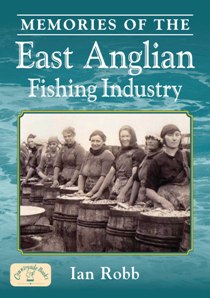
Through war and peace, good times and bad, the fishermen of East Anglia have put to sea and braved the stormy North Sea to earn their living. For countless generations fishing has been a way of life with sons following in the footsteps of fathers and grandfathers.
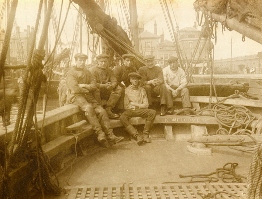
MEMORIES OF THE EAST ANGLIAN FISHING INDUSTRY by local author IAN ROBB uses first-hand accounts and a fascinating collection of old and contemporary photographs to tell the story of the fishermen of East Anglia; the conditions, the work, the people and their humour.
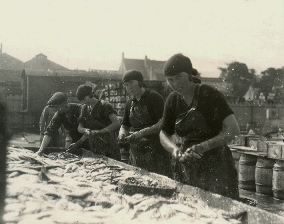
One of the greatest losses to the East Anglian fishing industry has been the Scots fishergirls. They travelled from port to port, gutting, pickling and packing herring by the million as they went. In East Anglia vast number of these Scots lassies could be found in Great Yarmouth, Gorleston and Lowestoft throughout the herring season.
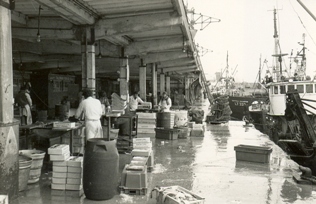
Ernie Childs of Great Yarmouth recalled his early life on the Fish Wharf in the 1950s and retains his affection for the lassies. ‘They were “girls” no matter how old they were. When you’re down with them, it’s lovely. You used to be among them and they were singing away. It was a wonderful atmosphere.’
Those who fished off the coast of East Anglia faced, and still face, potential danger every time they put to sea. Jim Nolloth recalls ‘I’ve been on the deck for the skipper for thirty-six to forty-eight hours on a stretch and nearly got washed overboard. That would be the Montserrat then, when she shipped a hell of a sea – filled the thing right up.’
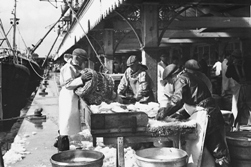
Life has never been easy for the fishermen of East Anglia but, with the decline in fish stocks and government restrictions, it is becoming more and more difficult to make a living from the sea. For most, a way of life which had come down from father to son to grandson, has vanished but this book will ensure that their memories live on.
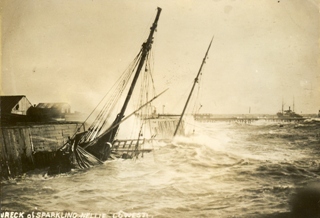
‘What has emerged in the interviews I have undertaken is the passion which this way of life engenders in the men who risk their lives every time they set out from the fishing ports of East Anglia’, says author Ian Robb. ‘I feel very privileged to have known such wonderful people’.
Chapter 1 A Short Tour of the Ports
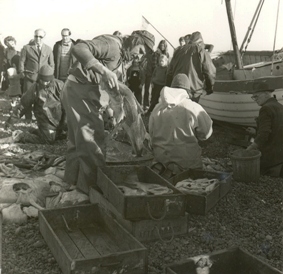
Rosemary Crisp of Kessingland recalls, ‘During 1940s and 1950s our summer holidays were spent with Aunt Elizabeth and Uncle Jack Gutteridge in Sheringham – Early in the morning Auntie would give me a large basket and my two brothers and I would walk down to the seashore, find Auntie’s favourite boatman and buy some crabs. He would place the wriggling claw-snapping creatures in my basket. On the walk home the crabs would climb up the side and my brothers would push them down to the bottom. At Auntie’s I would place the basket on a large well-scrubbed kitchen table and run out of the room. Us youngsters used to hate to hear the horrible sound that the crabs made when they were immersed in the pot. We ate the crabs at teatime; they were sweet, delicate and delicious’
Doug Ellis of Ipswich recalls seeing members of Crawford family fishing on Orwell in 1947 – ‘The family had the fishing rights to part of the river. Grandfather Crawford used to be a water bailiff at Ipswich. Once a year, Mr Crawford junior, although then in his 70s would forego the River Orwell and load the family complete with fishing boat onto the railway and head off to Wales to fish for eels there instead!’
Chapter 4 Trades and Industries
The Scots Fishergirls – one of greatest loses to the East Anglian fishing industry has been the disappearance not only of the Scots drifters but of the fishergirls themselves. The girls moved south following the fishing, travelling from port to port, gutting, pickling and packing herring by the million as they went. In East Anglia vast numbers of these Scots lassies could be found in Great Yarmouth, Gorleston and Lowestoft and, at one time, at Southwold, throughout the autumn herring season.
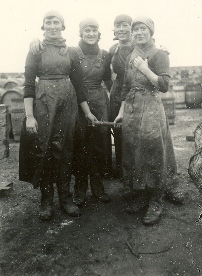
They could gut sixty herring a minute – one every second! The worked in teams of three, two gutting the fish while a third packed them into the barrels.
Ernie Childs of Great Yarmouth recalled his early life on the Fish Wharf in the 1950s and retains his affection for these lassies ‘I’ve grown up with these old girls, y’see. They were ‘girls’ no matter how old they were. When you’re down with them, it’s lovely. [As a young child] you used to be among them and they were singing away. It was a wonderful atmosphere. It’s a wonderful way to grow up. You couldn’t understand half of them though! I used to spend most of my time down the Harbour.’
Ernie also recalled the hundreds of boats moored at Yarmouth during the height of the herring season in the 1950s. On a Sunday morning when all the Scots crews had gone to church, locals wishing to visit relatives on the other side of the river would climb across from one boat to the other to get from Great Yarmouth to Gorleston, rather than walk the half mile around and over the Haven Bridge!
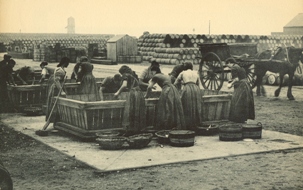
Maureen Fryers of Lowestoft clearly recalls the Scots girls ‘We just couldn’t believe it when we saw them walking down the street knitting away, talking, and doing all this lovely ‘Fair Isle’. And they were just jabbering away. But didn’t they work hard. They were really hardy women.’
But for those youngsters whose mothers opened up their homes to the girls, even the children themselves were enthralled over the dexterity of these strangely dressed women and their ever-moving fingers – a fascination that has now passed into fishing legend. Jeanette Nolloth, remembers their knitting! ‘they were lovely. They used to knit us Fair Isle jumpers, Tammy hats, gloves, they used to do. They were so quick how they packed them herring in those barrels.’
To buy the book please see www.countrysidebooks.co.uk, and for more information on present-day fishing please see Fishing in Suffolk.
